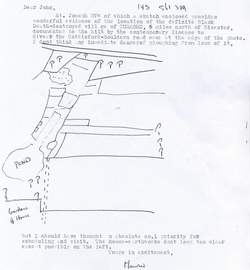We know where Tusmore is, but access to it is not always easy. The great Maurice Beresford went there about fifty years ago. Immediately after his visit he sent a letter to John Hurst that included a rough sketch of the main earthworks. In the letter he stressed that the site was an absolute no. 1 for scheduling and visit, and he ended “Yours in excitement, Maurice”. His letter is reproduced on the left.
David Miles and Trevor Rowley went back to Tusmore twenty years later to carry out a thorough investigation of the earthworks. Their findings are reported in the article in Oxoniensia mentioned earlier. They include:
· A block of five roughly rectangular enclosures (marked A on the adjoining plan). There are traces of house platforms on the eastern side of these enclosures.
· A hollow way (marked B) entering the village from the west. It may represent the old road from Souldern that was diverted by Roger de Cottisford.
· Another hollow way further north (C) with more enclosures containing house platforms on its northern side (D).
· An area of confused earthworks (E) which may have been the site of the church. There appears to have been a church at Tusmore since the late eleventh century. After the abandonment of the village it ceased to be a parish church, but it continued in use for about two centuries, probably serving as a private chapel for the family who lived on the estate.
· More house platforms (F and G).
· Two large rectangular enclosures (H and J) with a headland (K) at their northern end. These enclosures may have been used as fields before the abandonment of Tusmore, or they may have been created as a feature of the park that was developed later.
I had an opportunity to visit Tusmore in November 2010. I went there with my friend John Hall. With the help of the map from the article by Miles and Rowley we found the boundaries of a row of crofts, several likely house platforms, the holloway through which the main street probably ran, and the group of earthworks where the church may have stood.
Several large houses have been constructed at Tusmore over the centuries. The present house was completed in 2004 at a cost of £30,000,000. It has won awards for the quality of its architecture and the design of its interior, but not all opinions about it have been entirely complimentary.

